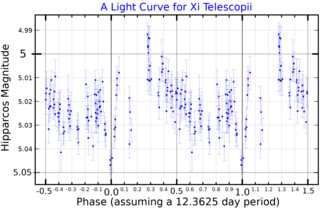
Xi Telescopii, Latinized from ξ Telescopii, is a solitary star in the southern constellation of Telescopium. It is visible to the naked eye, with an apparent visual magnitude of +4.95. Based upon an annual parallax shift of 3.02 mas as measured from Earth, it is located approximately 1,100 light-years from the Sun.

Zeta Ursae Minoris, which is Latinized from ζ Ursae Minoris, is a single star in the northern circumpolar constellation of Ursa Minor, forming the northernmost part of the bowl in this "little dipper" asterism. The star has a white hue and is faintly visible to the naked eye with an apparent visual magnitude of +4.28. It is located at a distance of approximately 369 light-years from the Sun based on parallax, but is drifting further closer with a radial velocity of about –13 km/s.

R Horologii is a red giant star approximately 760 light-years away in the southern constellation of Horologium. It is a Mira variable with a period of 404.83 days, ranging from apparent magnitude 4.7 to 14.3—one of the largest ranges in brightness known of stars in the night sky visible to the unaided eye. The star is losing mass at the rate of 5.9×10−7 M☉·y−1.
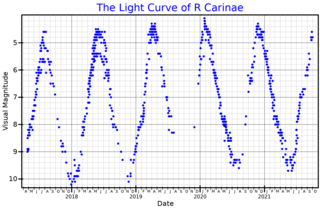
R Carinae is a double star in the southern constellation of Carina. The brighter component is a variable star that can be viewed with the naked eye at peak brightness, but is usually too faint to be seen without a telescope, having an apparent visual magnitude that fluctuates around 7.43. This star is located at a distance of approximately 1,300 light years from the Sun based on parallax, and is drifting further away with a radial velocity of +28 km/s.
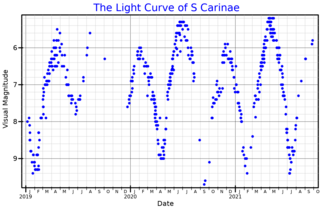
S Carinae is a variable star in the constellation Carina.
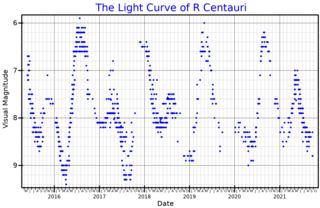
R Centauri is a Mira variable star in the constellation Centaurus.

κ Lyrae, Latinized as Kappa Lyrae, is a solitary star in the northern constellation of Lyra, near the constellation border with Hercules. It is visible to the naked eye as a faint, orange-hued point of light with an apparent visual magnitude of 4.33. This object is located approximately 252 light years from the Sun based on parallax, but is moving closer with a radial velocity of −24 km/s.

R Virginis is a Mira variable in the constellation Virgo. Located approximately 530 parsecs (1,700 ly) distant, it varies between magnitudes 6.1 and 12.1 over a period of approximately 146 days. Its variable nature was discovered by Karl Ludwig Harding in 1809.
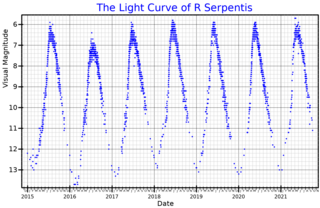
R Serpentis is a Mira variable type star in the equatorial constellation of Serpens. It ranges between apparent magnitude 5.16 and 14.4, and spectral types M5e to M8e, over a period of 356.41 days. The variability of this star was discovered in 1826 by Karl Ludwig Harding.
HD 194244 is a variable Be star in the equatorial constellation of Aquila. With an apparent magnitude of 6.14, according to the Bortle scale it is faintly visible to the naked eye from rural skies on a dark night.
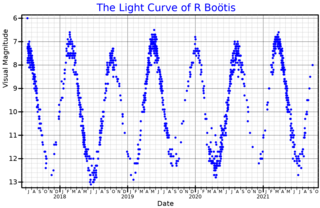
R Boötis is a variable star in the northern constellation of Boötes. Typically the star is too faint to be readily visible to the naked eye, with a brightness that fluctuates between apparent visual magnitudes of 9.98. The distance to this star is approximately 2,150 light years based on parallax measurements. It is drifting closer with a radial velocity of about −58 km/s.

μ Normae, Latinised as Mu Normae, is a blue supergiant star of spectral type O9.7 Iab, located in the constellation of Norma.
Nu Herculis, Latinized from ν Herculis, is a binary and variable star in the constellation of Hercules. With an apparent magnitude of about 4.4, it is faintly visible to the naked eye. Parallax measurements made by the Hipparcos spacecraft put it at a distance of about 860 light years.
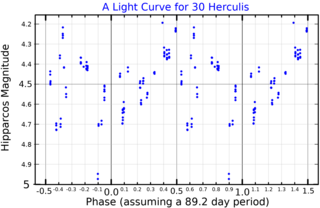
g Herculis is a binary star system in the northern constellation of Hercules. It has the Flamsteed designation 30 Herculis, while g Herculis is the Bayer designation. This system is visible to the naked eye as a faint, red-hued point of light. Based upon a measured parallax of 9.2 mas, it is located around 354 light years away from the Sun. The system is moving further from the Earth with a heliocentric radial velocity of 1.5 km/s.
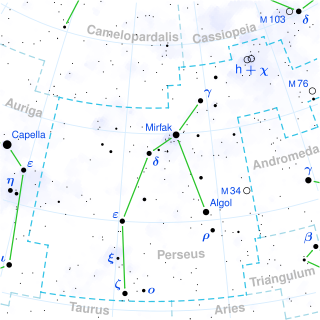
b Persei is a spectroscopic triple star in the constellation Perseus. Its apparent magnitude is 4.60, and it is about 320 light years away.
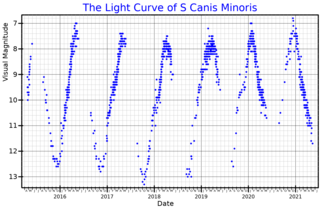
S Canis Minoris is a variable star in the equatorial constellation Canis Minor. It has a peak apparent visual magnitude of 6.5, so not normally visible to the naked eye. The star is located at a distance of approximately 1,530 light-years from the Sun based on stellar parallax, and is drifting further away with a radial velocity of about +68 km/s.
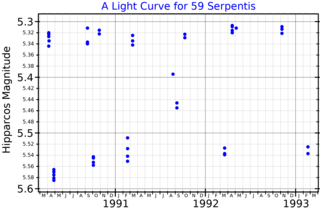
59 Serpentis, also known as d Serpentis, is a multiple star in the constellation Serpens. The system shows irregular variations in brightness between magnitudes 5.17 and 5.29.
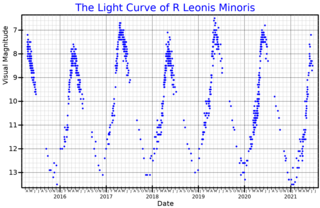
R Leonis Minoris is a Mira variable type star in the constellation Leo Minor. It ranges between apparent magnitude 6.3 and 13.2, and spectral types M6.5e to M9.0e (Tc:), over a period of 372 days.
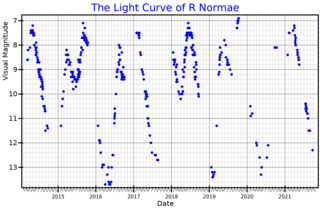
R Normae is a Mira variable star located near Eta Normae in the southern constellation of Norma. This is an intermediate-mass red giant star that is generating part of its energy through hydrogen fusion. Because this fusion is thought to be occurring under conditions of convection, it is generating an excess of lithium. The star ranges from magnitude 6.5 to 12.8 and has a relatively long period of 496 days. Located around 2,900 light-years distant, it shines with a luminosity 7764 times that of the Sun and has a surface temperature of 3161 K.
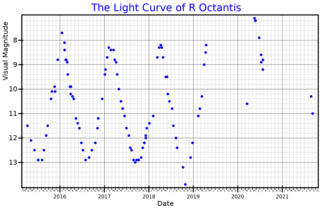
R Octantis, also known as HD 40857, is a solitary, red hued variable star located in the southern circumpolar constellation Octans. It has an apparent magnitude that varies in-between 6.4 and 13.2 within 405 days. At is maximum, it is barely visible to the naked eye. The object is located relatively far at a distance of about 1,900 light years based on parallax measurements from Gaia DR3, but is receding with a heliocentric radial velocity of 46 km/s.


















